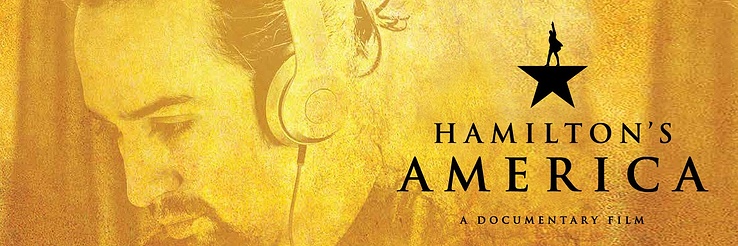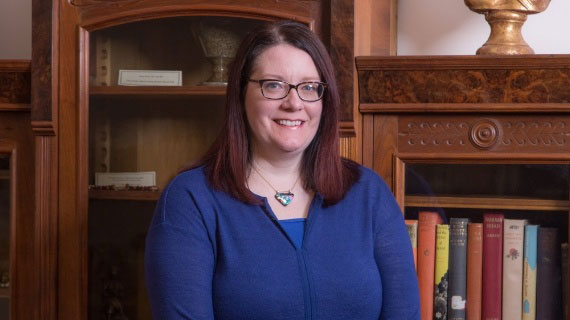Hamilton's America: A Historian's Perspective
Posted: October 24, 2016 | Author: Michelle Orihel | Read Time: 8 minutes
The following is a presentation by Michelle Orihel, assistant professor of early American History at Southern Utah University, given October 20, 2016:
 I’m a historian, a professional historian. I have the credentials to prove it— three degrees in history, a Bachelor’s degree, a Master’s degree, and a Ph.D. I have taught thousands of students over the course of my career and I have several publications to my name. I’m a professional. And, I have a confession to make tonight: I’m in love with the musical, “Hamilton.” I’ve been listening to it for nearly a year and I just can’t stop. Wait a minute? Did I just admit to that in public? You see. I’m not supposed to like “Hamilton.” Historians are supposed to have an antagonistic relationship with popular culture, especially when popular culture dares take on history as its subject. Ask a historian about Disney’s “Pocahontas,” and we will want to pull out our hair. Ask us about Mel Gibson’s “Patriot,” and our minds will explode in rage or maybe we’ll just break down and cry.
I’m a historian, a professional historian. I have the credentials to prove it— three degrees in history, a Bachelor’s degree, a Master’s degree, and a Ph.D. I have taught thousands of students over the course of my career and I have several publications to my name. I’m a professional. And, I have a confession to make tonight: I’m in love with the musical, “Hamilton.” I’ve been listening to it for nearly a year and I just can’t stop. Wait a minute? Did I just admit to that in public? You see. I’m not supposed to like “Hamilton.” Historians are supposed to have an antagonistic relationship with popular culture, especially when popular culture dares take on history as its subject. Ask a historian about Disney’s “Pocahontas,” and we will want to pull out our hair. Ask us about Mel Gibson’s “Patriot,” and our minds will explode in rage or maybe we’ll just break down and cry.
So, what’s going on here? What makes me like Hamilton? That’s what I wanted to talk about for the next few minutes — why I find the musical compelling and why I think the musical represents an important opportunity for historians to engage in a public discussion about what is to be gained from studying history, particularly the history of the American Revolution and early republic.
First, I want to make a critical distinction between a work of history and a work of the historical imagination. The musical “Hamilton” is not a work of history. Works of history are deeply researched and their conclusions and arguments are supported by ample evidence presented in citations like footnotes. Historians love footnotes. That’s professional history. That’s the kind of history that I write and love, and it’s vital that we teach it in our schools and universities. “Hamilton” is not that kind of history. Instead, it’s a work of the historical imagination, a literary work or a musical work that takes history for its inspiration and draws on history for its setting, its plot, and its characters. The musical is, therefore, more like Shakespeare’s history plays than a work of history. Professional historians do not own a monopoly on the past. Artists and painters and writers from Shakespeare to Lin-Manuel Miranda also tell stories about the past, stories that even historians can learn from.
Therefore, when I’m talking about “Hamilton” tonight, I’m not assessing it as history. If I were to do that I’d focus on its inaccuracies, distortions, and misrepresentations of the past. (That sounds quite fun to me actually). But, for the most part, I’ll restrain myself and focus on the positive, what I find compelling in the musical as a work of the historical imagination.
What appeals to me the most is its representation of the “Founding Fathers” as real human beings. Traditionally, we memorialize the Founders in stone monuments and marble statues, or we visualize them in paintings as those men dressed up so impressively in their powdered wigs and knee breeches. Some might revere the Founders as heroes; others might revile them as hypocrites. On the one hand, they are presented as all-knowing, wise, and perfect men who knew exactly what was going on and had the solution to every problem then and now. On the other hand, they are dead white men who lived a long time ago, antiquated and out of date, irrelevant, with nothing to say to Americans living in the 21st century. But, one thing is clear either way — the Founding Fathers are not like us. We can’t relate to them. We can’t connect to them. We don’t have anything in common with them. Case closed: We think we know their story.
But, we don’t. This is why history in Miranda’s “Hamilton” seems so new to many people. In that musical, history is in the moment, raw and uncertain. History seems to be told in our time, like it could be happening today. There are arguments, rivalries, jealousies, challenges, and struggles. And, Miranda so effectively and movingly captures these moments of struggle and doubt in the musical.
 One of those moments is George Washington during the Revolutionary War as portrayed in the three songs, “Right Hand Man,” “Stay Alive,” and “History Has Its Eyes on You.” These songs present Washington and the Continental Army that he leads through the acute crisis that they faced at the beginning of the war. “We are outgunned, outmanned, outnumbered, out-planned,” sings Washington. He’s not so sure that the American army is going to win this war, which is understandable given that the upstart colonials were fighting against the British Empire, the biggest superpower on the planet at the time. “Any hope of success is fleeting,” Washington laments: “Our odds are beyond scary.” He complains that he’s “Working with a 1/3 of what Congress has promised” and that “he’s in dire need of assistance.”
One of those moments is George Washington during the Revolutionary War as portrayed in the three songs, “Right Hand Man,” “Stay Alive,” and “History Has Its Eyes on You.” These songs present Washington and the Continental Army that he leads through the acute crisis that they faced at the beginning of the war. “We are outgunned, outmanned, outnumbered, out-planned,” sings Washington. He’s not so sure that the American army is going to win this war, which is understandable given that the upstart colonials were fighting against the British Empire, the biggest superpower on the planet at the time. “Any hope of success is fleeting,” Washington laments: “Our odds are beyond scary.” He complains that he’s “Working with a 1/3 of what Congress has promised” and that “he’s in dire need of assistance.”
This presentation of Washington as strong yet afraid, uncertain, frustrated, and struggling against great obstacles contrasts sharply with traditional depictions of him. Perhaps some of you are familiar with the paintings and statues that depict “The Apotheosis of Washington,” which shows Washington becoming like a god and ascending into Heaven. He’s barely human there. And, then, there’s the Washington monument, which of course is only an obelisk. It does not even depict Washington in human form. But, in Miranda’s “Hamilton,” we see Washington up close and struggling. Miranda reminds us that American military victory and Washington’s triumph was not foreordained a success. He makes Washington human and vulnerable by placing him in this volatile historical moment when the future of an independent America was up in the air, and that makes for a compelling study in leadership.
The tendency to memorialize the Founders makes us take the history for granted. It doesn’t really motivate us to study the complexities and nuances of the era. If we think of the Founders as unchanging statues and monuments, then there’s not much else to know about them. When we place the Founders in their proper historical context, the incredibly dynamic times in which they lived, they seem like subjects worthy of our study. All of sudden, their world, which previously seemed dusty, antiquated, — something that belongs on display in a museum, becomes a world in motion, a world of struggle, experiment, and argument in which the outcome is not clear at all.
The song that expresses this experience best is “Wait for It.” For me, that song represents the emotional core of the musical. Interestingly, it’s sung by Aaron Burr, Hamilton’s chief antagonist in the musical and in life. The most recent biography of Burr is entitled “Fallen Founder” because, of course, besides shooting Hamilton to death, Burr was later accused of treason against the United States. His reputation is less than pristine. It’s ironic, then, that the emotional heart of the musical comes from this “Fallen Founder,” or maybe it isn’t ironic at all. “Wait for It” is Burr’s reflection on life, love, death, as well as his reflection on the significance of Alexander Hamilton. The chorus goes:
Life doesn’t discriminate between the sinners and the saints.
It takes, and it takes, and it takes
We keep living anyway
We rise, and we fall, we break, and we make our mistakes.
The song is all about restlessness, the restlessness that was present at the Founding of our nation, the restlessness that we all feel sometimes in coping with our day to day struggles. It’s also about the drive to persevere despite the adversities that we face, universal themes and experiences that we can all relate to.
One of musical’s tag lines is “America then, told by America now,” but that’s not quite accurate because the musical effectively blurs the boundary between the past and the present. In telling the story of the past, historians try to overcome that distance between the past and the present. At first, history might seem unfamiliar, different, and even mysterious, but historians seek to immerse you in that past world, so that you feel connected to it. That’s what Miranda has done in “Hamilton.” Fans feel an immediate connection to the American Revolution and the early republic because the “Founders” are depicted as human beings with flaws and faults, often at very vulnerable points, maybe even breaking points in their lives. This presentation resonates with us. The songs hold great meaning for us. Miranda’s memorable words and lines have become part of our lives, part of how we experience the world.
“I’ve been reading Common Sense by Thomas Paine,” sings Angelica Schuyler in the musical. The other day I had a student tell me that that’s the line that ran through her head when she was reading Common Sense by Thomas Paine in one of my classes. So, where does history end and where does our present begin? I’m not so sure there’s a separation.
As a historian, I take the musical “Hamilton” as a starting point for a conversation about the past. I’d like to challenge all of you, then, to do the same. I challenge all you fans of “Hamilton” to take your passion for this musical one step further and become engaged in the history of the American Revolution and the Early Republic. Read a biography of Hamilton or one about Lafayette or maybe even John Adams. (I just had to mention John Adams. He’d get jealous if I didn’t.) Or even better take a history class. You’ll discover that there’s even more to know about Hamilton and the Founders than you imagined.
This article was published more than 3 years ago and might contain outdated information or broken links. As a result, its accuracy cannot be guaranteed.
Tags: College of Humanities and Social Sciences Faculty College of Performing and Visual Arts




